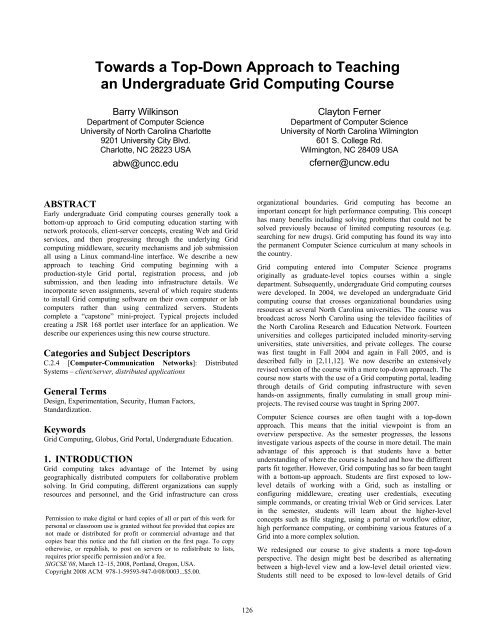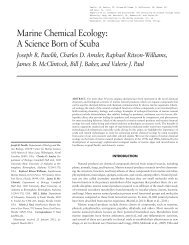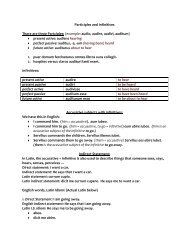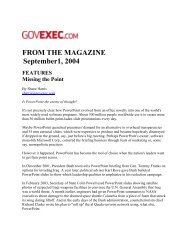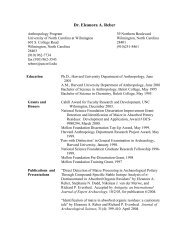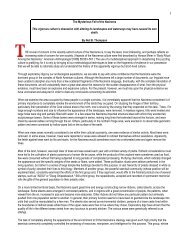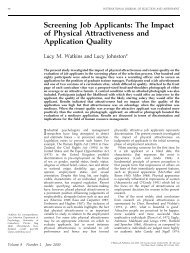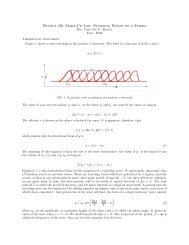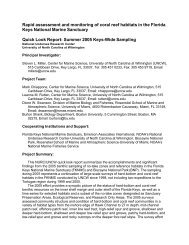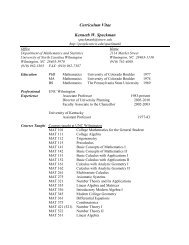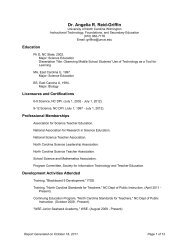Towards a Top-Down Approach to Teaching an ... - ResearchGate
Towards a Top-Down Approach to Teaching an ... - ResearchGate
Towards a Top-Down Approach to Teaching an ... - ResearchGate
You also want an ePaper? Increase the reach of your titles
YUMPU automatically turns print PDFs into web optimized ePapers that Google loves.
<strong>Towards</strong> a <strong>Top</strong>-<strong>Down</strong> <strong>Approach</strong> <strong>to</strong> <strong>Teaching</strong><br />
<strong>an</strong> Undergraduate Grid Computing Course<br />
Barry Wilkinson<br />
Department of Computer Science<br />
University of North Carolina Charlotte<br />
9201 University City Blvd.<br />
Charlotte, NC 28223 USA<br />
abw@uncc.edu<br />
ABSTRACT<br />
Early undergraduate Grid computing courses generally <strong>to</strong>ok a<br />
bot<strong>to</strong>m-up approach <strong>to</strong> Grid computing education starting with<br />
network pro<strong>to</strong>cols, client-server concepts, creating Web <strong>an</strong>d Grid<br />
services, <strong>an</strong>d then progressing through the underlying Grid<br />
computing middleware, security mech<strong>an</strong>isms <strong>an</strong>d job submission<br />
all using a Linux comm<strong>an</strong>d-line interface. We describe a new<br />
approach <strong>to</strong> teaching Grid computing beginning with a<br />
production-style Grid portal, registration process, <strong>an</strong>d job<br />
submission, <strong>an</strong>d then leading in<strong>to</strong> infrastructure details. We<br />
incorporate seven assignments, several of which require students<br />
<strong>to</strong> install Grid computing software on their own computer or lab<br />
computers rather th<strong>an</strong> using centralized servers. Students<br />
complete a “caps<strong>to</strong>ne” mini-project. Typical projects included<br />
creating a JSR 168 portlet user interface for <strong>an</strong> application. We<br />
describe our experiences using this new course structure.<br />
Categories <strong>an</strong>d Subject Descrip<strong>to</strong>rs<br />
C.2.4 [Computer-Communication Networks]: Distributed<br />
Systems – client/server, distributed applications<br />
General Terms<br />
Design, Experimentation, Security, Hum<strong>an</strong> Fac<strong>to</strong>rs,<br />
St<strong>an</strong>dardization.<br />
Keywords<br />
Grid Computing, Globus, Grid Portal, Undergraduate Education.<br />
1. INTRODUCTION<br />
Grid computing takes adv<strong>an</strong>tage of the Internet by using<br />
geographically distributed computers for collaborative problem<br />
solving. In Grid computing, different org<strong>an</strong>izations c<strong>an</strong> supply<br />
resources <strong>an</strong>d personnel, <strong>an</strong>d the Grid infrastructure c<strong>an</strong> cross<br />
Permission <strong>to</strong> make digital or hard copies of all or part of this work for<br />
personal or classroom use is gr<strong>an</strong>ted without fee provided that copies are<br />
not made or distributed for profit or commercial adv<strong>an</strong>tage <strong>an</strong>d that<br />
copies bear this notice <strong>an</strong>d the full citation on the first page. To copy<br />
otherwise, or republish, <strong>to</strong> post on servers or <strong>to</strong> redistribute <strong>to</strong> lists,<br />
requires prior specific permission <strong>an</strong>d/or a fee.<br />
SIGCSE’08, March 12–15, 2008, Portl<strong>an</strong>d, Oregon, USA.<br />
Copyright 2008 ACM 978-1-59593-947-0/08/0003...$5.00.<br />
126<br />
Clay<strong>to</strong>n Ferner<br />
Department of Computer Science<br />
University of North Carolina Wilming<strong>to</strong>n<br />
601 S. College Rd.<br />
Wilming<strong>to</strong>n, NC 28409 USA<br />
cferner@uncw.edu<br />
org<strong>an</strong>izational boundaries. Grid computing has become <strong>an</strong><br />
import<strong>an</strong>t concept for high perform<strong>an</strong>ce computing. This concept<br />
has m<strong>an</strong>y benefits including solving problems that could not be<br />
solved previously because of limited computing resources (e.g.<br />
searching for new drugs). Grid computing has found its way in<strong>to</strong><br />
the perm<strong>an</strong>ent Computer Science curriculum at m<strong>an</strong>y schools in<br />
the country.<br />
Grid computing entered in<strong>to</strong> Computer Science programs<br />
originally as graduate-level <strong>to</strong>pics courses within a single<br />
department. Subsequently, undergraduate Grid computing courses<br />
were developed. In 2004, we developed <strong>an</strong> undergraduate Grid<br />
computing course that crosses org<strong>an</strong>izational boundaries using<br />
resources at several North Carolina universities. The course was<br />
broadcast across North Carolina using the televideo facilities of<br />
the North Carolina Research <strong>an</strong>d Education Network. Fourteen<br />
universities <strong>an</strong>d colleges participated included minority-serving<br />
universities, state universities, <strong>an</strong>d private colleges. The course<br />
was first taught in Fall 2004 <strong>an</strong>d again in Fall 2005, <strong>an</strong>d is<br />
described fully in [2,11,12]. We now describe <strong>an</strong> extensively<br />
revised version of the course with a more <strong>to</strong>p-down approach. The<br />
course now starts with the use of a Grid computing portal, leading<br />
through details of Grid computing infrastructure with seven<br />
h<strong>an</strong>ds-on assignments, finally cumulating in small group miniprojects.<br />
The revised course was taught in Spring 2007.<br />
Computer Science courses are often taught with a <strong>to</strong>p-down<br />
approach. This me<strong>an</strong>s that the initial viewpoint is from <strong>an</strong><br />
overview perspective. As the semester progresses, the lessons<br />
investigate various aspects of the course in more detail. The main<br />
adv<strong>an</strong>tage of this approach is that students have a better<br />
underst<strong>an</strong>ding of where the course is headed <strong>an</strong>d how the different<br />
parts fit <strong>to</strong>gether. However, Grid computing has so far been taught<br />
with a bot<strong>to</strong>m-up approach. Students are first exposed <strong>to</strong> lowlevel<br />
details of working with a Grid, such as installing or<br />
configuring middleware, creating user credentials, executing<br />
simple comm<strong>an</strong>ds, or creating trivial Web or Grid services. Later<br />
in the semester, students will learn about the higher-level<br />
concepts such as file staging, using a portal or workflow edi<strong>to</strong>r,<br />
high perform<strong>an</strong>ce computing, or combining various features of a<br />
Grid in<strong>to</strong> a more complex solution.<br />
We redesigned our course <strong>to</strong> give students a more <strong>to</strong>p-down<br />
perspective. The design might best be described as alternating<br />
between a high-level view <strong>an</strong>d a low-level detail oriented view.<br />
Students still need <strong>to</strong> be exposed <strong>to</strong> low-level details of Grid
computing fairly early in the semester <strong>to</strong> give time for them <strong>to</strong><br />
deal with more complex concepts. However, we feel that the new<br />
design gives students a new perspective that puts all lessons in<strong>to</strong> a<br />
cohesive context. In this paper, we discuss the design of the<br />
course <strong>an</strong>d our efforts <strong>to</strong> ch<strong>an</strong>ge the perspective <strong>to</strong> a <strong>to</strong>p-down<br />
approach.<br />
2. RELATED WORK<br />
One of the first funded projects for teaching Grid computing at<br />
the undergraduate level was <strong>an</strong> NSF Course, Curriculum, <strong>an</strong>d<br />
Labora<strong>to</strong>ry Improvement (CCLI) project awarded <strong>to</strong> Bina<br />
Ramamurthy <strong>an</strong>d Bharat Jayaram<strong>an</strong> in 2003 [6]. This was a<br />
collaborative project between SUNY at Buffalo <strong>an</strong>d SUNY<br />
College at Geneseo. The project resulted in courses being offered<br />
at the adv<strong>an</strong>ced undergraduate level from a distributed computer<br />
system perspective beginning with RMI (remote method<br />
invocation). In 2004, NSF funded two further CCLI projects on<br />
undergraduate Grid computing education. In one project,<br />
investiga<strong>to</strong>rs at the University of Ark<strong>an</strong>sas (Amy Apon) <strong>an</strong>d at<br />
Lewis <strong>an</strong>d Clark College (Jens Mache) developed a collaborative<br />
undergraduate Grid computing course [7]. In the other project,<br />
investiga<strong>to</strong>rs at UNC-Charlotte (Barry Wilkinson), Western<br />
Carolina University (Mark Holliday), <strong>an</strong>d UNC-Wilming<strong>to</strong>n<br />
(Clay<strong>to</strong>n. Ferner) developed a collaborative undergraduate Grid<br />
computing course [8]. We describe in this paper a continuation of<br />
that project. All previous projects concentrated upon comm<strong>an</strong>dline<br />
interfaces <strong>an</strong>d distributed computing techniques [1, 3, 4, 5].<br />
3. COURSE DETAILS<br />
3.1 Student Resources<br />
The course home page, located at<br />
http://www.cs.uncc.edu/~abw/ITCS4146S07/ provided access <strong>to</strong><br />
everything the students needed, including more th<strong>an</strong> 800<br />
PowerPoint lecture slides, reading list, assignment instructions,<br />
WebCT for assignment submission <strong>an</strong>d multiple-choice quizzes,<br />
course Grid portal, <strong>an</strong>d streaming video recordings of classes<br />
available <strong>to</strong> students during the semester. Figure 1 shows a<br />
sample of the streaming video with the three universities that<br />
participated in the course experiment (UNC-Asheville, UNC-<br />
Charlotte, <strong>an</strong>d UNC-Wilming<strong>to</strong>n). Previously, we had m<strong>an</strong>y<br />
universities participating in the course, but because of the major<br />
ch<strong>an</strong>ges we made, we limited participation.<br />
Figure 1. NCREN Streaming video of class<br />
127<br />
Some new <strong>an</strong>d revised assignments called for students <strong>to</strong> install<br />
complex Grid computing software on their own computer (or lab<br />
computers) rather th<strong>an</strong> use the main Grid computing systems. Past<br />
experience with students using a central system for software<br />
development was fraught with problems, as we shall describe<br />
later. The software is available for Windows, Linux, <strong>an</strong>d Mac<br />
although all the students in the class of Spring 2007 used<br />
Windows systems. Using personal or lab computers was one of<br />
the successes of the redevelopment. Of course, we had <strong>to</strong> establish<br />
at the beginning that everyone had access <strong>to</strong> a computer.<br />
3.2 Assignment 1: Using a Grid Portal<br />
We started the course with <strong>an</strong> early assignment in the first class<br />
even before getting in<strong>to</strong> the details of Grid computing, which<br />
asked students <strong>to</strong> register themselves as users using a Grid portal.<br />
Our Grid portal is based upon the Gridsphere <strong>to</strong>olkit [9], a widely<br />
used portal <strong>to</strong>olkit in production Grids. A Grid portal provides<br />
single sign-on <strong>to</strong> all Grid resources, that is, once logged in with a<br />
password, access c<strong>an</strong> be made <strong>to</strong> reach local <strong>an</strong>d dist<strong>an</strong>t resources<br />
without having <strong>to</strong> supply passwords subsequently. The course<br />
Grid portal is shown in Figure 2.<br />
Figure 2. Main portal login page<br />
We installed the PURSe registration portlet [10], which greatly<br />
simplifies account set-up. Students select the registration tab on<br />
the portal main page, which leads them <strong>to</strong> the PURSe registration<br />
form shown in Figure 3. They then enter details <strong>an</strong>d request <strong>an</strong><br />
account.<br />
Figure 3. Registration portlet
Fill in form<br />
Provide<br />
password<br />
<strong>an</strong>d other<br />
information<br />
New<br />
User<br />
Course on-line<br />
registration<br />
form<br />
Email requestacknow<br />
ledge<br />
sequence<br />
System<br />
Create accounts, Administra<strong>to</strong>r<br />
set access control,<br />
sign certificate, …<br />
Contact other<br />
grid resource<br />
administra<strong>to</strong>rs if<br />
users requests<br />
account on their<br />
resource<br />
Figure 4 Registration process<br />
Behind the scenes, a number of activities occur as illustrated in<br />
Figure 4. These activities are somewhat hidden from the students<br />
at this stage. Student will not underst<strong>an</strong>d the creation of<br />
credentials (private key <strong>an</strong>d certificate request). Although the<br />
students did not yet underst<strong>an</strong>d what is happening for them, they<br />
are becoming oriented <strong>to</strong> the Grid through the portal interface. It<br />
was import<strong>an</strong>t for the students <strong>to</strong> do these first few steps<br />
immediately so that we could get certificates signed <strong>an</strong>d issued<br />
<strong>an</strong>d they could proceed with the rest of the assignment.<br />
After certificates were signed <strong>an</strong>d placed on the MyProxy server,<br />
students could complete the assignment, again using the portal, by<br />
getting a proxy <strong>an</strong>d submitting a simple job <strong>to</strong> execute on the<br />
Grid. They test the system with a prewritten job (Linux echo<br />
comm<strong>an</strong>d). They then write a simple program in Java (fac<strong>to</strong>rial<br />
program), compile it <strong>to</strong> a class file on their own or a lab computer,<br />
which is then uploaded in<strong>to</strong> the server for execution using the<br />
GridFTP portlet within the portal. Hence, students get experience<br />
in using the portal <strong>to</strong> do some basic tasks.<br />
While the students are working on this first assignment, we<br />
delivered the lectures on <strong>an</strong> overview of Grid computing,<br />
including <strong>to</strong>pics such as Grid computing concepts, virtual<br />
org<strong>an</strong>izations, computational Grid projects, Grid computing<br />
networks, Grid computing infrastructure, <strong>an</strong>d software<br />
components. Up <strong>to</strong> this point, the students have been introduced<br />
<strong>to</strong> the concept of a Grid as a computing resource. They know that<br />
there are machines they c<strong>an</strong> put <strong>to</strong> use <strong>to</strong> accomplish some task.<br />
How that happens was still a mystery <strong>to</strong> them.<br />
3.3 Assignment 2: Using the Grid Through a<br />
Comm<strong>an</strong>d Line<br />
In the second assignment, students accomplish the same tasks as<br />
in Assignment 1, except that everything is done through the<br />
comm<strong>an</strong>d line. Students must create a certificate request, submit it<br />
<strong>to</strong> the Certificate Authority, create a job submission file, <strong>an</strong>d<br />
submit the job <strong>to</strong> the Globus Grid Resource Allocation <strong>an</strong>d<br />
M<strong>an</strong>agement (GRAM). The assignment has not ch<strong>an</strong>ged<br />
signific<strong>an</strong>tly from previous offerings of the course. However, we<br />
still include the assignment <strong>to</strong> contrast job submission from a<br />
comm<strong>an</strong>d line interface against a portal interface as well as <strong>to</strong><br />
give students a perspective of what the portal is doing for them<br />
under the surface.<br />
128<br />
In the lectures at this point, we cover the comm<strong>an</strong>d line interface<br />
approach <strong>to</strong> Grid computing as well as delivered lectures on<br />
XML, Job M<strong>an</strong>agement, Web Services, <strong>an</strong>d Security.<br />
3.4 Assignment 3: Using a Scheduler <strong>to</strong> Submit<br />
a Job<br />
Next in the course are lectures on schedulers <strong>an</strong>d <strong>an</strong> assignment<br />
using a scheduler such as Condor or Sun Grid Engine. We used<br />
Condor in Fall 2004 <strong>an</strong>d Sun Grid Engine in Fall 2005. Sun Grid<br />
Engine required a third-party adapter for the Globus Grid<br />
computing software but has a nice GUI interface. For Spring<br />
2007, we returned <strong>to</strong> Condor as it provides interesting features for<br />
job matching through ClassAd <strong>an</strong>d workflow though DAGM<strong>an</strong><br />
<strong>an</strong>d is widely used as a cluster scheduler. There is also a Grid<br />
version of Condor called Condor-G.<br />
In the assignment, students are asked <strong>to</strong> create a job submission<br />
file <strong>an</strong>d submit a job <strong>to</strong> the Condor scheduler. It was our intention<br />
that the students be able <strong>to</strong> submit jobs <strong>to</strong> the Globus container<br />
through Condor as well as <strong>to</strong> Condor through Globus, giving them<br />
a view of local versus meta-scheduling, but this was left for a<br />
future offering of the course <strong>to</strong>gether with true meta-scheduling.<br />
We did however have a guest speaker later in the course describe<br />
real-life meta-scheduling using Gridway.<br />
3.5 Assignment 4: Installing the GT4 Core <strong>an</strong>d<br />
testing a simple GT4 Grid service<br />
The next part of the course is a return <strong>to</strong> the low-level details of<br />
creating a Grid service, which is a key aspect of recent of Grid<br />
middleware. We delivered lectures on concepts such as Globus<br />
4.0 Grid services, using Web services for Grid computing, stateful<br />
Web services, Grid computing st<strong>an</strong>dards, Open Grid Services<br />
Architecture (OGSA), Web Services Resource Framework<br />
(WSRF), programming GT 4.0 Grid services, <strong>an</strong>d the GT 4.0<br />
container. Students are given <strong>an</strong> assignment <strong>to</strong> create, build, <strong>an</strong>d<br />
deploy a Grid service, then use the Grid service by creating,<br />
building, <strong>an</strong>d using a client.<br />
In previous offerings of the course, this assignment was done<br />
earlier in the course <strong>an</strong>d required students <strong>to</strong> use one of the<br />
servers at their institution. However, this did not work out well.<br />
The original Grid service assignment required students <strong>to</strong> create<br />
their own Grid service, which requires a Grid service container<br />
host. Using one container (or multiple containers operating on<br />
different ports) requires all students’ services <strong>to</strong> be uniquely<br />
named, which was done previously by running a script that<br />
renamed student services. When a student needed <strong>to</strong> modify <strong>an</strong>d<br />
re-deploy the service, it was necessary <strong>to</strong> restart the container <strong>to</strong><br />
see the service. Students would do this m<strong>an</strong>y times <strong>an</strong>d redeployment<br />
would affect all students using the same container. It<br />
was easily possible <strong>to</strong> overload or crash the system. Asking<br />
students <strong>to</strong> do the service development on their personal<br />
computers eliminated such problems. However, students needed<br />
<strong>to</strong> install the Globus core <strong>an</strong>d associated software <strong>to</strong> do this work.<br />
The software required for Spring 2007 was JDK 1.4.2+, Ant<br />
1.5.1+, Python 2.4+, <strong>an</strong>d Globus 4.0 core. Installing the software<br />
is quite easy <strong>to</strong> do although m<strong>an</strong>y students had not downloaded<br />
<strong>an</strong>d installed such software before. The software required more<br />
low-level work th<strong>an</strong> most Windows software they had installed.<br />
They had <strong>to</strong> obtain packages from different sources <strong>an</strong>d set
environment variables <strong>an</strong>d paths. Once installed, students needed<br />
<strong>to</strong> issue comm<strong>an</strong>ds at a Windows comm<strong>an</strong>d prompt.<br />
We did provide a version of the assignment that used a server<br />
(basically the 2004/2005 assignment) as a backup pl<strong>an</strong> for those<br />
students that might not be able <strong>to</strong> install the software, but all of<br />
the students m<strong>an</strong>aged <strong>to</strong> install the software on Windows<br />
computers. (None of the students in the Spring 2007 class used<br />
Linux or a Mac although they could have done so.)<br />
3.6 Assignment 5: Using GridNexus <strong>to</strong> Create<br />
Workflows that use Web <strong>an</strong>d Grid Services<br />
We returned <strong>to</strong> user interfaces in the next phase of the course <strong>an</strong>d<br />
gave the students <strong>an</strong> assignment where they have <strong>to</strong> interact with<br />
Web services <strong>an</strong>d submit jobs using a workflow edi<strong>to</strong>r. In this<br />
assignment, the students are asked <strong>to</strong> install the GridNexus<br />
workflow edi<strong>to</strong>r software <strong>an</strong>d create workflows that would use<br />
Web <strong>an</strong>d Grid services. Although the students used personal<br />
computers for GridNexus, the software functions as the client <strong>to</strong><br />
services on a Grid machine. We w<strong>an</strong>ted <strong>to</strong> have students use<br />
GridNexus <strong>to</strong> interact with the Grid service that they themselves<br />
built <strong>an</strong>d deployed but this would be difficult for students who<br />
were not successful with Assignment 4. It is desirable <strong>to</strong> have<br />
each assignment be as self-contained as possible. Therefore, we<br />
provided the services the students could use in this assignment.<br />
After configuring GridNexus <strong>to</strong> work with the services, students<br />
are asked <strong>to</strong> create workflows that created service inst<strong>an</strong>ces, make<br />
use of them <strong>to</strong> accomplish some task, <strong>an</strong>d then destroy the service<br />
inst<strong>an</strong>ces. Students are also asked <strong>to</strong> submit a job <strong>to</strong> run on a<br />
remote machine using the workflow edi<strong>to</strong>r through the Globus<br />
GRAM. They could then contrast this job submission with using a<br />
Portal (Assignment 1), using a comm<strong>an</strong>d line (Assignment 2), <strong>an</strong>d<br />
using a scheduler (Assignment 3). Similar <strong>to</strong> a Portal, GridNexus<br />
will hide m<strong>an</strong>y of the low-level steps necessary <strong>to</strong> submit a job<br />
such as the construction of the job submission file.<br />
3.7 Assignment 6: Portlet Design<br />
This was a completely new assignment for Spring 2007 in<br />
keeping with introducing a higher-level interface <strong>to</strong> students. It<br />
also required students <strong>to</strong> use their own computer. Students are<br />
asked <strong>to</strong> create, build, deploy, <strong>an</strong>d use a portlet inside a portal<br />
container that they installed. It is necessary for them <strong>to</strong> install<br />
GridSphere <strong>an</strong>d other software (such as ANT <strong>an</strong>d Tomcat). After<br />
successfully installing <strong>an</strong>d running the container <strong>an</strong>d GridSphere,<br />
students then had <strong>to</strong> create a prewritten JSR 168 portlet, build it,<br />
deploy it in GridSphere, <strong>an</strong>d then code their own portlet. Figure 5<br />
shows a sample student portlet as a front-end <strong>to</strong> a simple math<br />
program.<br />
Figure 5. Student Math Portlet<br />
129<br />
This may not look difficult, but it requires student <strong>to</strong> underst<strong>an</strong>d,<br />
code, <strong>an</strong>d deploy a JSR 168 portlet. They have <strong>to</strong> write the<br />
underlying Java math program, which calls a JSP file (Java Server<br />
Pages) <strong>an</strong>d modify several deployment descrip<strong>to</strong>r XML files, get<br />
it <strong>to</strong> work, <strong>an</strong>d write up the work in a report, all in a week or so<br />
(including installing the software).<br />
3.8 Assignment 7: MPI Assignment<br />
At this stage in the course, we move on <strong>to</strong> parallel computing<br />
using MPI <strong>an</strong>d high perform<strong>an</strong>ce computing. Students are given<br />
<strong>an</strong> assignment <strong>to</strong> create a parallel program using MPI, build it,<br />
<strong>an</strong>d submit it for execution on the Grid. In Assignment 7, students<br />
are asked <strong>to</strong> create MPI programs <strong>to</strong> implement matrix<br />
multiplication <strong>an</strong>d dot product. (Students could install MPI on<br />
their own computer for code development if they wished although<br />
we are not aware of <strong>an</strong>y who did.) We were only able <strong>to</strong> spend a<br />
few lectures on parallel computation, so we could not ask them <strong>to</strong><br />
implement <strong>an</strong>ything more complicated. Furthermore, the<br />
communication latencies between geographically dist<strong>an</strong>t<br />
processors are <strong>to</strong>o large <strong>to</strong> make it feasible <strong>to</strong> employ parallel<br />
computation that requires a signific<strong>an</strong>t amount of communication.<br />
Applications that are suitable for parallel execution on a Grid<br />
include such things as “embarrassingly parallel” applications <strong>an</strong>d<br />
Monte Carlo applications. However, <strong>an</strong> assignment such as this<br />
one only introduces the students <strong>to</strong> the possibilities that parallel<br />
execution promises as well as the elusiveness of speedup.<br />
3.9 Mini-project<br />
The mini-project was also new for Spring 2007. Students worked<br />
in teams of three students. Each team is given the objective of<br />
creating a new Grid computing assignment that builds upon the<br />
previous assignments <strong>an</strong>d concepts learned in the class, <strong>an</strong>d<br />
produce <strong>an</strong> assignment write-up with the solution. The assignment<br />
should involve the creation of a Grid computing application<br />
combined with a graphical interface such as a workflow edi<strong>to</strong>r or<br />
a portal. Note the requirement of a high-level user interface. We<br />
provided students with a list of possible mini-project ideas, but<br />
they could design their own assignment. Whichever they chose,<br />
they had <strong>to</strong> present a single page write-up describing the idea for<br />
our approval by a published date, after which they could start in<br />
earnest. Students are asked <strong>to</strong> design the work as a class<br />
assignment that could be given <strong>to</strong> their classmates. We did this so<br />
that we might use their mini-projects as actual assignments in<br />
future classes. Furthermore, this requirement would give students<br />
a way <strong>to</strong> focus on the dissemination of the project. Finally,<br />
student teams had <strong>to</strong> prepare a report written as a class assignment<br />
<strong>an</strong>d present <strong>to</strong> the class a 10-minute presentation of what they did,<br />
what they accomplished, <strong>an</strong>d what they learned.<br />
While students were working on their mini-projects, we invited<br />
three expert guests who are working on real-world Grid projects<br />
<strong>to</strong> give presentations on those projects. These presentations gave<br />
students <strong>an</strong> appreciation that Grids are more th<strong>an</strong> just<br />
experimental systems.<br />
4. EXPERIENCES<br />
Our experiences have been very positive. It does require immense<br />
work <strong>to</strong> prepare for a h<strong>an</strong>ds-on Grid computing course. It is<br />
critical that all assignments are fully tested prior <strong>to</strong> the start of<br />
class <strong>an</strong>d that all computer systems are reliable <strong>an</strong>d the software<br />
maintained. The assignments went much smoother by requiring
students <strong>to</strong> use personal computers when possible. Students<br />
responded positively <strong>to</strong> using their own computers that were<br />
under their direct control. Some students did have problems with<br />
their installations but nothing that could not resolved quickly such<br />
as not setting paths or using the wrong version of the software. In<br />
one case, using a most recent version of JDK (1.6 instead of the<br />
versions it was tested on: JDK 1.4.2 <strong>an</strong>d JDK 1.5) turned out <strong>to</strong> be<br />
incompatible. Certainly some Grid computing assignments still<br />
have <strong>to</strong> be done on a Grid platform, such as submitting <strong>an</strong>d<br />
scheduling jobs, but using personal computers where possible<br />
simplifies code development. Th<strong>an</strong>kfully, we did not experience<br />
<strong>an</strong>y students causing catastrophic system problems with installing<br />
the software on their personal computer although we warned<br />
students <strong>to</strong> checkpoint their system prior <strong>to</strong> installation. Most lab<br />
machines were installed with Deep Freeze that insured students<br />
would not cause them <strong>to</strong> be inoperable. The only downside of<br />
using Deep Freeze is that the students had <strong>to</strong> complete their<br />
assignment in one sitting or repeat the installation.<br />
In Spring 2007, we had increased the number of assignments from<br />
four <strong>to</strong> seven <strong>an</strong>d added a mini-project so it was critical that no<br />
one got behind with assignments in the 15-week semester. Each<br />
assignment was allocated 1-2 weeks <strong>to</strong> complete (3 weeks for<br />
mini-project). As with the Fall 2005, we posted three dates for<br />
each assignment, a date the assignment was set, a date that<br />
students had <strong>to</strong> report <strong>an</strong>y system problems that were preventing<br />
them from proceeding with the assignment (roughly 3-4 days after<br />
the date set) <strong>an</strong>d a date the assignment was <strong>to</strong> be submitted. The<br />
date <strong>to</strong> report system problems required students <strong>to</strong> start the<br />
assignment immediately. It turned out that in Spring 2007, no one<br />
reported systems problems <strong>an</strong>d each assignment could move<br />
forward on schedule.<br />
5. CONCLUSIONS<br />
In this paper, we describe a new version of a geographically<br />
distributed undergraduate Grid computing course, which uses a<br />
more <strong>to</strong>p-down approach, <strong>an</strong>d starts with production-style Grid<br />
computing portal. We also introduced JSR 168 portlet design <strong>an</strong>d<br />
a mini-project that brought <strong>to</strong>gether the materials in the course.<br />
Our new course calls for students <strong>to</strong> install some complex<br />
software on their own computer or lab computers in order <strong>to</strong> do<br />
some assignments. This approach signific<strong>an</strong>tly reduces the<br />
problems of a class attempting Grid computing work on a<br />
centralized server, especially Grid service code development.<br />
6. ACKNOWLEDGMENTS<br />
This material is based upon work supported by the National<br />
Science Foundation under Gr<strong>an</strong>t No. 0533334. Any opinions,<br />
findings, <strong>an</strong>d conclusions or recommendations expressed in this<br />
material are those of the authors <strong>an</strong>d do not necessarily reflect the<br />
views of the National Science Foundation. We wish <strong>to</strong> th<strong>an</strong>k our<br />
teaching assist<strong>an</strong>ts at UNC-Charlotte, Jeremy Villalobos <strong>an</strong>d<br />
Jasper L<strong>an</strong>d who were responsible for maintaining the Grid<br />
platform <strong>an</strong>d assisted in the development of the assignments. We<br />
very much appreciated Dr. De<strong>an</strong> Brock, the chairm<strong>an</strong> of the<br />
Department of Computer Science at UNC-Asheville who was in<br />
attend<strong>an</strong>ce at lectures <strong>an</strong>d served as the faculty contact at UNC-<br />
130<br />
Asheville. We also appreciate all the students in the Grid<br />
computing class of Spring 2007 who helped make the course a<br />
success. Class member Aurora Cain did the student portlet design<br />
shown in Figure 5.<br />
7. REFERENCES<br />
[1] Apon A., Mache J.,Yara Y., <strong>an</strong>d L<strong>an</strong>drus K., Classroom<br />
exercises for grid services, Proceedings of the Linux Cluster<br />
Institute International Conference on High Perform<strong>an</strong>ce<br />
Computing, Austin, Texas, May, 2004.<br />
[2] Holliday M.A., Wilkinson B., House J., Daoud S., Ferner C.,<br />
Geographically-distributed, assignment-structured<br />
undergraduate grid computing course, in The 36th ACM<br />
Technical Symposium on Computer Science Education<br />
(SIGCSE2005), St. Louis, Missouri, pp. 206-210, February<br />
23-27, 2005.<br />
[3] Mache, J., <strong>an</strong>d Apon, A., Grid computing in the<br />
undergraduate classroom <strong>to</strong>pics, exercises <strong>an</strong>d experiences,<br />
Cluster Computing <strong>an</strong>d the Grid 2005 (CCGrid), vol. 1, pp.<br />
67- 73, May 2005.<br />
[4] Mache, J., <strong>an</strong>d Apon A., <strong>Teaching</strong> grid computing: <strong>to</strong>pics,<br />
exercises, <strong>an</strong>d experiences, IEEE Tr<strong>an</strong>sactions on Education,<br />
Vol. 50, No. 1, pp. 3-9, Feb. 2007.<br />
[5] Mache, J., H<strong>an</strong>ds-on grid computing with Globus Toolkit 4,<br />
Journal of Computing Sciences in Colleges, Vol. 22, No. 2,<br />
pp. 99 – 100, Dec. 2006.<br />
[6] National Science Foundation gr<strong>an</strong>t, “Collaborative: A Multi-<br />
Tier Model for Adaptation of Grid Technology <strong>to</strong> CS-based<br />
Undergraduate Curriculum,” ref. DUE # 0311473, PI: B.<br />
Ramamurthy, co-PI: B. Jayaram<strong>an</strong>, 2003-2006.<br />
[7] National Science Foundation gr<strong>an</strong>t, “Collaborative Project:<br />
Adaptation of Globus Toolkit 3 Tu<strong>to</strong>rials for Undergraduate<br />
Computer Science Students,” ref. DUE #0410966/#0411237,<br />
PIs: A. Apon <strong>an</strong>d J. Mache, 2004-2007.<br />
[8] National Science Foundation gr<strong>an</strong>t, “Introducing Grid<br />
Computing in<strong>to</strong> the Undergraduate Curricula,” ref. DUE<br />
#0410667/0533334, PI: A. B. Wilkinson, co-PI M. Holliday,<br />
2004-2007.<br />
[9] The OGCE Portal Toolkit. http://www.collabogce.org/ogce2/<br />
[10] PURSe: Portal-based User Registration Service.<br />
http://www.grids-center.org/solutions/purse/<br />
[11] Wilkinson, B., <strong>an</strong>d Ferner, C., <strong>Teaching</strong> grid computing in<br />
North Carolina: Two part series, IEEE Distributed Systems<br />
Online, vol. 7, no. 6&7, 2006, art. nos. 0606-o6003 <strong>an</strong>d<br />
0607-o7003.<br />
[12] Wilkinson B., Holliday M., <strong>an</strong>d Ferner C., Experiences in<br />
teaching a geographically distributed undergraduate grid<br />
computing course, Proceedings of The Second International<br />
Workshop on Collaborative <strong>an</strong>d Learning Applications of<br />
Grid Technology <strong>an</strong>d Grid Education (Held in conjunction<br />
with CCGrid2005), May 9 - 12, 2005, Cardiff, United<br />
Kingdom.


